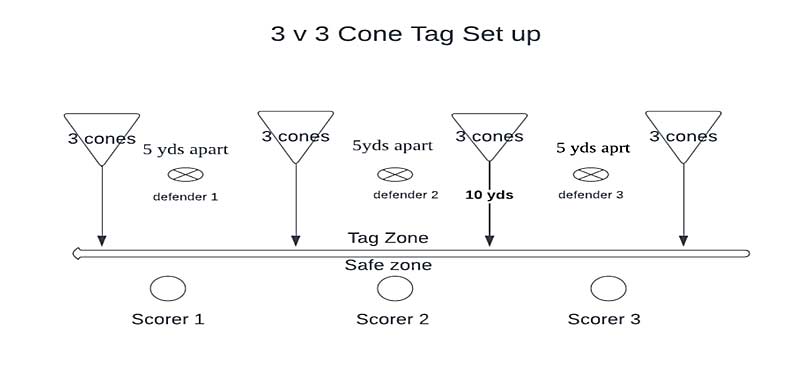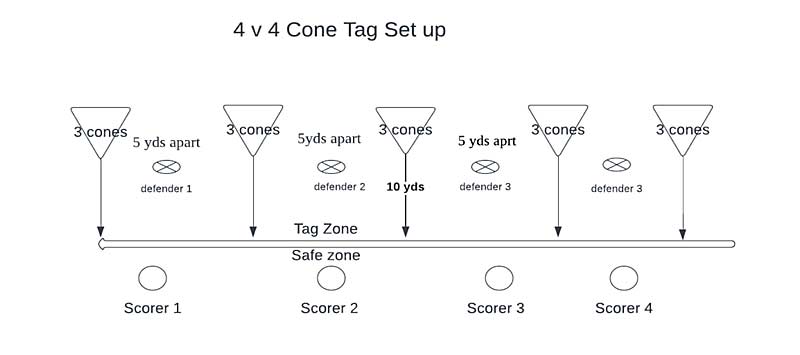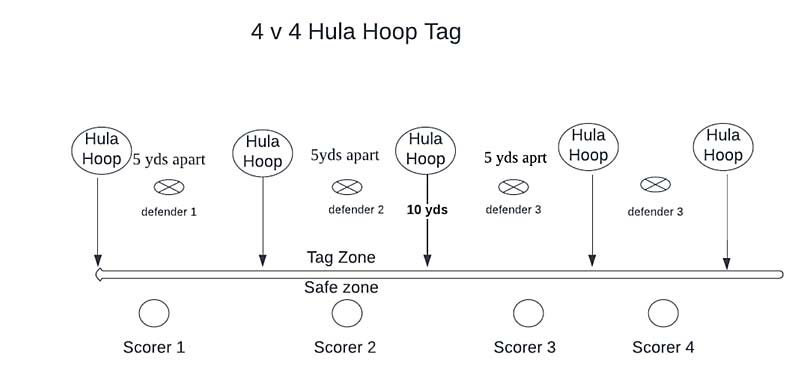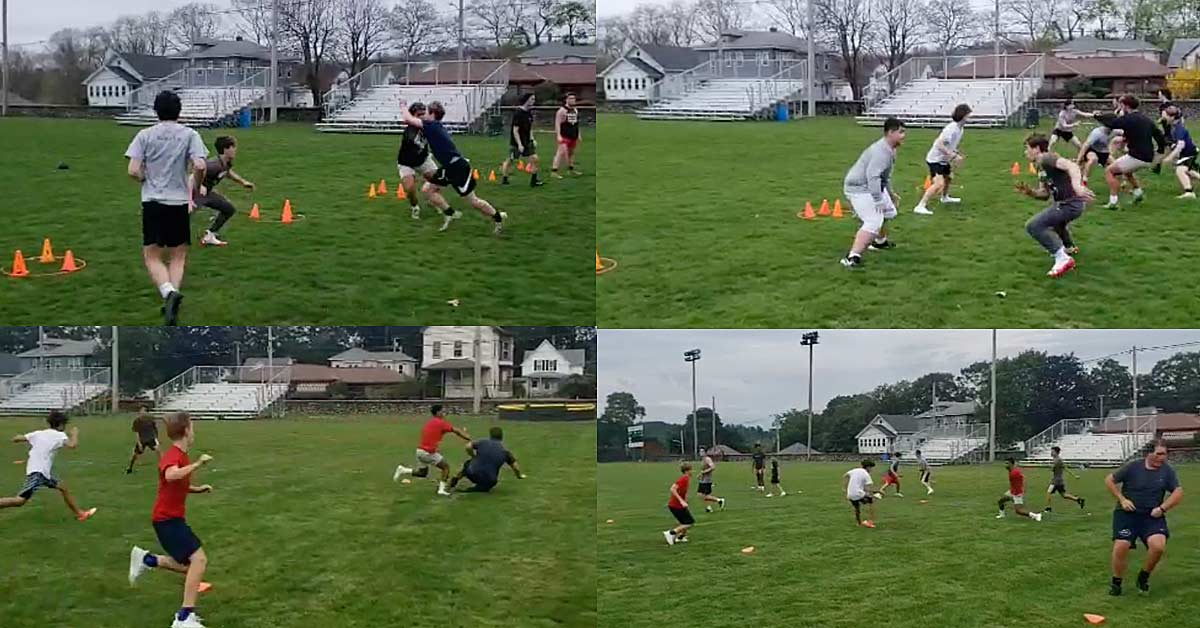As a strength and conditioning coach, youth sports coach, and dad of four growing kids, I’ve spent countless hours at various ball fields. Over the years, I have come up with hundreds of ideas involving many different activities, drills, and games in my never-ending quest to have fun and improve the athletic ability of the young athletes I’m working with. I wish I could say that all of these ideas were great…but many went down like lead balloon and ended up in the trash.
Every now and then, however, a gem emerges that stands the test of time.
At Teamworks sports performance in Clinton MA, we do not have the luxury of an outdoor field right next to the gym, so we often will do separate field sessions at one of the local football fields down the street. To be honest, I have always enjoyed getting out of the gym and on the field to open up on our speed training and do extra “movement skill” work. If anyone reading this has seen my articles, videos, and courses, they know how I feel about the importance of varied movement for the development of athletic abilities in young athletes. As much as I Iove the gym, nothing beats some open field space and little creativity.
Most young athletes these days spend an inordinate amount of time playing just one or two sports. Oftentimes, these sports are played non-stop, year-round. Gone are the days of kids playing outside with their friends, making up their own games. This change is unfortunate, because those marathon sessions of play activity were a great environment to develop and rehearse a variety of athletic skills. Consequently, these days, most young athletes are exposed to a very narrow range of movements throughout the year. They are always repeating the very specific movement skill-set that their sports require, while missing out on the variety of movements that playing other sports and games provides.
It’s no surprise, then, that pediatric sports injuries are on the rise—mostly because our current generation of young athletes are over-skilled and underdeveloped. This is the reason why gameplay has become such a huge part of my overall athletic development philosophy.
It’s no surprise, then, that pediatric sports injuries are on the rise—mostly because our current generation of young athletes are over-skilled and underdeveloped, says @JeremyFrisch. Share on XCone Chaos
Over the past decade, one game has emerged as a perennial fan favorite among all the athletes I coach: Cone Chaos. I have used this game with kids as young as elementary school all the way through college-level football players. From the name, you can probably guess that the game is another variation of the classic game of tag, but it’s so much more than that. Cone Chaos requires:
- Teamwork
- Offense and defense
- Scoring
- Time constraints
The beauty of this game is that the only real equipment needed is a stack of cones and a stopwatch. This is an important consideration when planning field sessions, because a lot of the time I can’t carry much equipment in my car other than some cones, bands, and tennis balls. This, in fact, is how the game was invented: I needed to come up with a game that was highly competitive, trained the skills that I wanted, and required minimal equipment and set-up time.
The beauty of this game is that the only real equipment needed is a stack of cones and a stopwatch. This is an important consideration when planning field sessions, says @JeremyFrisch. Share on XAlthough Cone Chaos can be played 2v2, it’s more fun and rewarding if you can play it as 3v3 or with even more players. So, for the purpose of this article, I’ll be explaining with 3v3 or above.
Enter Cone Chaos
Here’s a brief rundown of the game, with a diagram—there is a designated offensive team and a defensive team.
Rules
The defense must defend each cone area. Numerically, there is always one more cone area than there are defenders. For example, in this case, there are 3 defenders protecting 4 cone areas. In 4v4, there will be 4 defenders covering 5 cone areas. Defenders must tag offensive players trying to knock over the cones. Tagged players must “clear” themselves back out in the safe zone after being tagged.
Video 1. High school athletes playing cone chaos.
The offensive team has a set time (30-40 seconds) to knock down as many cones as possible, and players can only knock down one cone at a time. Each time an offensive player knocks down a cone or gets tagged, they must “clear” themselves by hustling back into the safe zone. Offensive players are allowed to score a knockdown in any cone area. They can also run up and down the safe zone area, where they cannot be tagged.
After the timed 30 seconds is up, teams count how many cones were knocked down. Then, they switch sides with offense going on defense and defense going on offense. After each team has gone through one round, the team with the most cones knocked down wins that game—we typically play a seven-game series, where the first to win four games is the overall winner.


Another great version of this game is played with hula hoops instead of cones. In this variation of the game, the offensive players have to simply step a foot inside the hula hoop to score.
Video 2. Young athletes play the hula hoop variation of Cone Chaos.
Rules
The offensive team has 30-40 sec to step into a hula hoop as many times as possible.
Each time an offensive player steps into a hula hoop or gets tagged, they must “clear” themselves by running back into the safe zone.
The defense must defend the hula hoop area. There is always one more hula hoop area than there are defenders. For example, in this case there are 4 defenders protecting 5 cone areas. Defenders must tag offensive players trying score/step into hula hoops. Tagged players must “clear” themselves in the safe zone after being tagged.
Video 3. Full team playing hula hoop version of Cone Chaos.
After 30 seconds is up, teams count how many times the offense stepped into the hoop areas. Then they switch sides. Offense goes on defense and defense goes on offense. After each team has gone through one round the team with the most hula hoop entries wins the game. In this variation, we also typically play a seven-game series, where the first to win four games is the overall winner.

Why We Play
Most field and court sport athletes find both versions of this game highly competitive and enjoyable. They feel there are many similarities to their sport skills—for example, there are similarities to playing zone defense in basketball, where an athlete covers an area rather than a man. Our offensive-minded football and basketball players love the strategy involved in creating the space needed to score.
Some of the most important athletic qualities evident in Cone Chaos:
- Creating space on offense for scoring
- Closing space on defense for tags
- Scoring
- Defensive positioning
- Acceleration
- Deceleration
- Tracking
- Reaction
- Change of direction
- Team work
- Strategy
- Conditioning
What I notice the most is that during game play, my athletes go all out. They push themselves much harder in a competitive situation than they ever do in training. In my opinion, if you want skills to transfer to sports, games are the golden ticket to bridge that gap between training and sport. Cone Chaos is a fun and highly competitive way to train the skills needed in field and court sports, and the beauty of this game is that it’s scalable both to the size of the team and to different ages.






